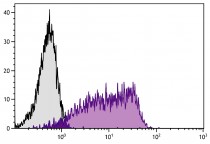ARG21386
anti-CD55 antibody [143-30] (PE)
anti-CD55 antibody [143-30] (PE) for Flow cytometry,IHC-Frozen sections,IHC-Formalin-fixed paraffin-embedded sections,Western blot and Human
Overview
| Product Description | PE-conjugated Mouse Monoclonal antibody [143-30] recognizes CD55 |
|---|---|
| Tested Reactivity | Hu |
| Tested Application | FACS, IHC-Fr, IHC-P, WB |
| Specificity | Human CD55. |
| Host | Mouse |
| Clonality | Monoclonal |
| Clone | 143-30 |
| Isotype | IgG1, kappa |
| Target Name | CD55 |
| Antigen Species | Human |
| Immunogen | PHA activated peripheral blood mononuclear cells |
| Conjugation | PE |
| Alternate Names | DAF; CD antigen CD55; CROM; Complement decay-accelerating factor; CR; TC |
Application Instructions
| Application Suggestion |
|
||||||||||
|---|---|---|---|---|---|---|---|---|---|---|---|
| Application Note | WB: Under non-reducing condition. * The dilutions indicate recommended starting dilutions and the optimal dilutions or concentrations should be determined by the scientist. |
Properties
| Form | Liquid |
|---|---|
| Buffer | PBS, 0.1% Sodium azide and Sucrose. |
| Preservative | 0.1% Sodium azide |
| Stabilizer | Sucrose |
| Storage Instruction | Aliquot and store in the dark at 2-8°C. Keep protected from prolonged exposure to light. Avoid repeated freeze/thaw cycles. Suggest spin the vial prior to opening. The antibody solution should be gently mixed before use. |
| Note | For laboratory research only, not for drug, diagnostic or other use. |
Bioinformation
| Database Links |
Swiss-port # P08174 Human Complement decay-accelerating factor |
|---|---|
| Gene Symbol | CD55 |
| Gene Full Name | CD55 molecule, decay accelerating factor for complement (Cromer blood group) |
| Background | This gene encodes a glycoprotein involved in the regulation of the complement cascade. Binding of the encoded protein to complement proteins accelerates their decay, thereby disrupting the cascade and preventing damage to host cells. Antigens present on this protein constitute the Cromer blood group system (CROM). Alternative splicing results in multiple transcript variants. The predominant transcript variant encodes a membrane-bound protein, but alternatively spliced transcripts may produce soluble proteins. [provided by RefSeq, Jul 2014] |
| Function | This protein recognizes C4b and C3b fragments that condense with cell-surface hydroxyl or amino groups when nascent C4b and C3b are locally generated during C4 and c3 activation. Interaction of daf with cell-associated C4b and C3b polypeptides interferes with their ability to catalyze the conversion of C2 and factor B to enzymatically active C2a and Bb and thereby prevents the formation of C4b2a and C3bBb, the amplification convertases of the complement cascade. [UniProt] |
| Calculated MW | 41 kDa |
| PTM | The Ser/Thr-rich domain is heavily O-glycosylated. |
Images (1) Click the Picture to Zoom In






